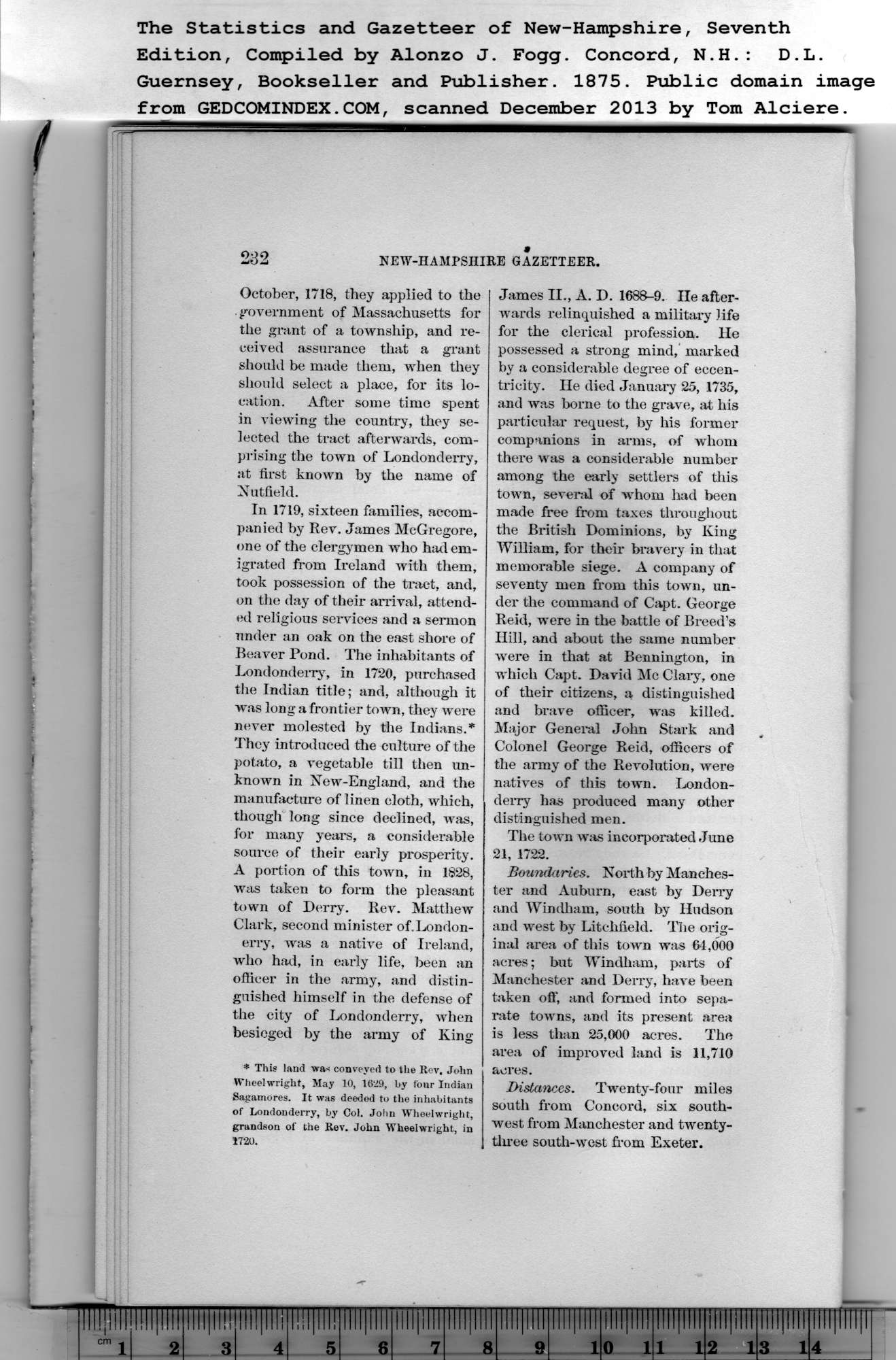|
232
9
NEW-HAMPSHIRE GAZETTEER.
The Statistics and Gazetteer of New-Hampshire, Seventh
Edition, Compiled by Alonzo J. Fogg. Concord, N.H.: D.L.
October, 1718, they applied to the
government of Massachusetts for
the grant of a township, and re-
ceived assurance that a grant
should be made them, when they
should select a place, for its lo-
cation. After some time spent
in viewing the country, they se-
lected the tract afterwards, com-
prising the town of Londonderry,
at first known by the name of
Nutfield.
In 1719, sixteen families, accom-
panied by Rev. James McGregore,
one of the clergymen who had em-
igrated from Ireland with them,
took possession of the tract, and,
on the day of their arrival, attend-
ed religious services and a sermon
under an oak on the east shore of
Beaver Pond. The inhabitants of
Londonderry, in 1720, purchased
the Indian title; and, although it
was long a frontier town, they were
never molested by the Indians.1
They introduced the culture of the
potato, a vegetable till then un-
known in New-England, and the
manufacture of linen cloth, which,
though long since declined, was,
for many years, a considerable
source of their early prosperity.
A portion of this town, in 1828,
was taken to form the pleasant
town of Derry. Rev. Matthew
Clark, second minister of.London-
erry, was a native of Ireland,
who had, in early life, been an
officer in the army, and distin-
guished himself in the defense of
the city of Londonderry, when
besieged by the army of King |
James II., A. D. 1688-9. He after-
wards relinquished a military life
for the clerical profession. He
possessed a strong mind, marked
by a considerable degree of eccen-
tricity. He died January 25, 1735,
and was borne to the grave, at his
particular request, by his former
companions in arms, of whom
there was a considerable number
among the early settlers of this
town, several of whom had been
made free from taxes throughout
the British Dominions, by King
William, for their bravery in that
memorable siege. A company of
seventy men from this town, un-
der the command of Capt. George
Reid, were in the battle of Breed’s
Hill, and about the same number
were in that at Bennington, in
which Capt. David Me Clary, one
of their citizens, a distinguished
and brave officer, was killed.
Major General John Stark and
Colonel George Reid, officers of
the army of the Revolution, were
natives of this town. London-
derry has produced many other
distinguished men.
The town was incorporated June
21, 1722.
Boundaries. North by Manches-
ter and Auburn, east by Derry
and Windham, south by Hudson
and west by Litchfield. The orig-
inal area of this town was 64,000
acres; but Windham, parts of
Manchester and Derry, have been
taken off, and formed into sepa-
rate tow ns, and its present area
is less than 25,000 acres. The
area of improved land is 11,710
acres.
Distances. Twenty-four miles
south from Concord, six south-
west from Manchester and twenty-
tln-ee south-west from Exeter. |
